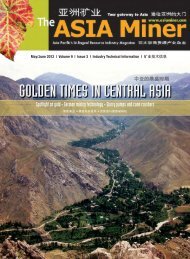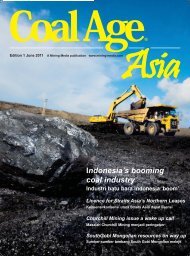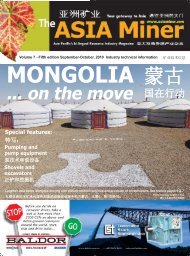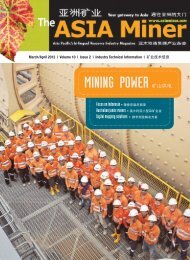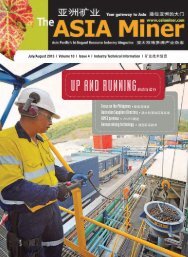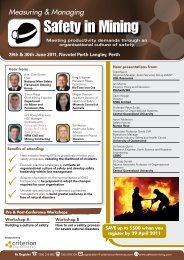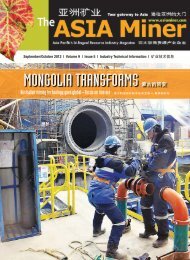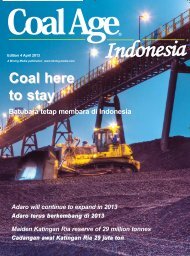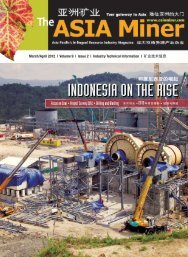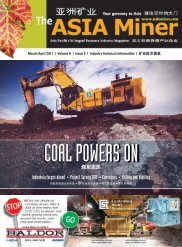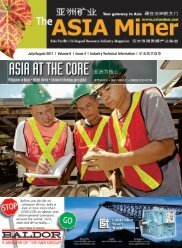May/June 2013 - The ASIA Miner
May/June 2013 - The ASIA Miner
May/June 2013 - The ASIA Miner
Create successful ePaper yourself
Turn your PDF publications into a flip-book with our unique Google optimized e-Paper software.
Mine Design<br />
TOOLS TO ASSIST IN<br />
planninganddesign<br />
As mining companies face rising costs and volatile commodity markets, making the right design decisions is a must. <strong>The</strong> <strong>ASIA</strong><br />
<strong>Miner</strong> looks at worrying capex trends, and some of the software available to help keep costs under control.<br />
By Simon Walker, European editor E&MJ<br />
OPTIMIZING resource utilization has always<br />
been a challenge for mine designers,<br />
with nature still eminently capable of<br />
throwing up surprises that can both delight<br />
or confound. Brownfield exploration is<br />
often the key to the former—take Neves<br />
Corvo in Portugal or Garpenberg in Sweden<br />
as examples here—while unforeseen<br />
stress regimes, water or weak strata are<br />
often the cause of forced changes in plan.<br />
Cameco’s flood-related tribulations at<br />
Cigar Lake are a case in point.<br />
In consequence, mine design systems<br />
have to be capable of addressing sudden<br />
amendments as well as providing the overall<br />
framework for getting the most out of a<br />
given deposit, in both tonnage and financial<br />
terms. Soviet-style planning focused on the<br />
former at the expense of the latter, while examples<br />
abound of operations that have<br />
been run exclusively on financial rails and<br />
have closed early, only to find new leases<br />
on life under a different operating regime.<br />
<strong>The</strong> development of mine design software,<br />
which has been on-going since the<br />
first systems such as Datamine were introduced<br />
over 30 years ago, has resulted in a<br />
strong supply base of competitive concepts.<br />
Not surprisingly, there has been a degree<br />
of consolidation within the mainstream<br />
players in recent years, as well as acquisitions<br />
of suppliers by larger companies who<br />
have realized that the mining-sector market<br />
is no longer a niche. Such moves can, of<br />
course, bring significant benefits in terms of<br />
having greater development resources<br />
available, as well as the potential to merge<br />
software systems with different focuses into<br />
more comprehensive packages. As with<br />
machinery manufacturers, the goal is often<br />
to be able to meet all of a customer’s needs<br />
from one source, rather than risking part of<br />
the business (and its potential for long-term<br />
support) going elsewhere.<br />
<strong>The</strong> latest release of Geovia’s MineSched software, version 8.0, provides a number of speed and schedule-visualization enhancements<br />
that allow users to quickly generate short- (top) and long-term (bottom) schedules necessary to meet a mine’s development<br />
and production targets.<br />
<strong>The</strong> Cost of Making Wrong Decisions<br />
Looking first at greenfield project development,<br />
one of the most obvious trends of the<br />
past 10 years has been the rapid escalation<br />
in capex costs that companies worldwide<br />
have had to face. One of the first examples<br />
to come to widespread notice was BHP Billiton’s<br />
Ravensthorpe nickel laterite project in<br />
60 | <strong>ASIA</strong> <strong>Miner</strong> | <strong>May</strong>/<strong>June</strong> <strong>2013</strong>



